What's to come during Open Field, the Walker Art Center's summer-long experiment on the cultural commons?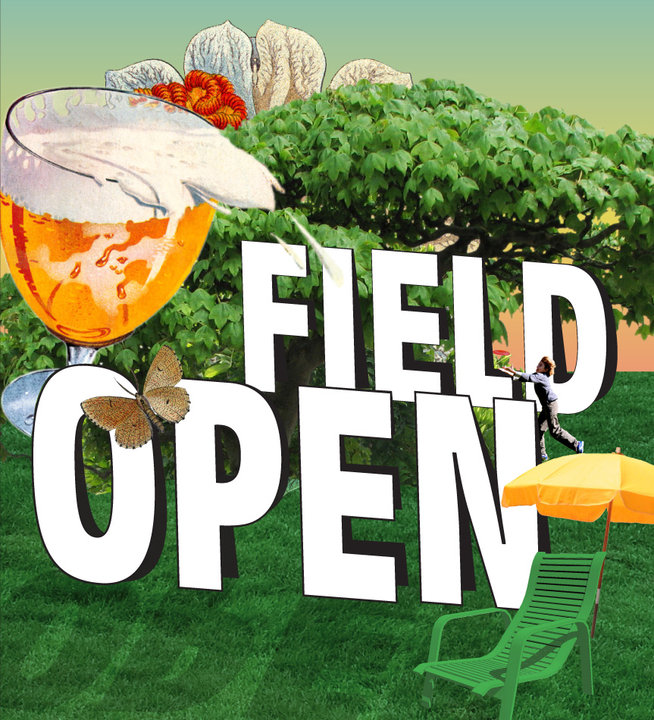 OPENING THE FIELD is the conversation and celebration kick-off event for Open Field. It's a chance to share ideas and pose questions about the cultural commons. What constitutes a community of shared ideas, artworks, and other resources? How do age-old ideas about the commons translate to today's digital world? Guests for this conversation present ideas from an array of fields, including new media, philosophy, education, law, and history.
OPENING THE FIELD is the conversation and celebration kick-off event for Open Field. It's a chance to share ideas and pose questions about the cultural commons. What constitutes a community of shared ideas, artworks, and other resources? How do age-old ideas about the commons translate to today's digital world? Guests for this conversation present ideas from an array of fields, including new media, philosophy, education, law, and history.
Opening the Field: A Conversation and Celebration Kick-Off
Thursday, June 3rd from 6-9PM
Walker Art Center, Bazinet Lobby and Cinema
Click for more information!
USING THIS DOCUMENT
This ThoughtMesh document aggregates the blog posts that introduce each of the five guest speakers. We've collected all five posts here, use the navigation to the left to read them individually. Use the ThoughtMesh tag cloud above to search all five posts at once for commonalities amongst them. Click on the "excerpts out" tab to search the entire ThoughtMesh database for similar commonalities.
ThoughtMesh was developed, in part, by Jon Ippolito, one of our five speakers at Opening the Field.
SPEAKERS INCLUDE (These links will take you outside of the ThoughtMesh.)
+ Michael Edson, Director of Web and New Media Strategy at the Smithsonian Institution, leading an initiative called the Smithsonian Commons.
+ Laura Musacchio, landscape design educator and researcher interested in human-nature interactions in metropolitan, cultural and bioregional landscapes.
+ Sumanth Gopinath, musicologist interested in the intersections of race, ethnicity, music and the ringtone industry.
+ Caroline Woolard, artist and co-founder of OurGoods, a barter network for independent projects.
+ Jon Ippolito, artist, writer and curator interested in building and sustaining networks and breaking down hierarchical media and culture.
MICHAEL EDSON: MUSEUM COMMONS by Shanai Matteson Michael Edson is the web and new media strategist for the world's largest museum complex, the Smithsonian, which holds over 137 million objects in the public trust. A person could spend a lifetime walking through the Smithsonian's museums and research centers and still not see everything there is to see, let alone read all of the labels. This sheer volume of objects and information is just one of the challenges the Smithsonian faces when considering how to make their resources accessible to audiences via the web and new media. Another more formidable challenge comes from the nature of the the web itself. While physical museums have traditionally been about hoarding stuff and authoring expert knowledge for public consumption, our new media tools encourage free and open sharing of creative works and ideas, valuing crowd-sourced knowledge over individual expertise. In this environment, how should museum content be created, shared and managed? What is the role of a museum in the digital commons? Michael will take up these questions and others at the Open Field kick-off event. He has a unique perspective from which to contemplate the vast cultural resources that museums represent. A painter and printmaker, he understands the importance of objects and their ability to teach and inspire. His first job at the Smithsonian was cleaning display cases, so he also knows the invisible dimensions of museum work that are so critical to how these institutions function. As a new media strategist, Michael has made it his goal to break down the display cases and walls that institutions historically place around their collections, and around themselves. Using web-based tools to encourage content-creation at all levels of museum staff and public, he hopes to redefine the role museums play in our society, looking to the old idea of the commons for inspiration. According to Michael, "Commons have historically been created when a property owner decides that a resource—be it grass for grazing sheep, land for parks or even intellectual property—will create more value if freely shared. A museum commons functions much in this same way. Ideas and creative works are shared freely, creating more value for society." The result of Michael's exploration of these ideas has been the creation of a new strategy for online engagement called The Smithsonian Commons. A new digital presence for the museum, the Smithsonian Commons "is dedicated to free and unrestricted sharing, and encourages new kinds of learning and creation through interaction with Smithsonian researchers, collections and communities." While on stage at the Walker Michael will share a few ideas that led him to this project, as well as how it has fundamentally changed the institution. He's hoping others will come with thoughts and ideas about the future possibilities of museum as commons. In our conversation, Michael pointed out that "Museums right now are asking themselves, how will we survive in the digital age?" It's a good question. It seems the days are long gone when people were satisfied with museums that act simply as knowledge creation and dissemination engines, or worse, as tombs for creative culture. Today's museums perform real, meaningful work in our society and artists and individuals are equipped to participate. Michael and others see the Walker's Open Field project as an opportunity to test out a museum commons in real time and space. Photo credit: BAR Photography / CC BY-ND 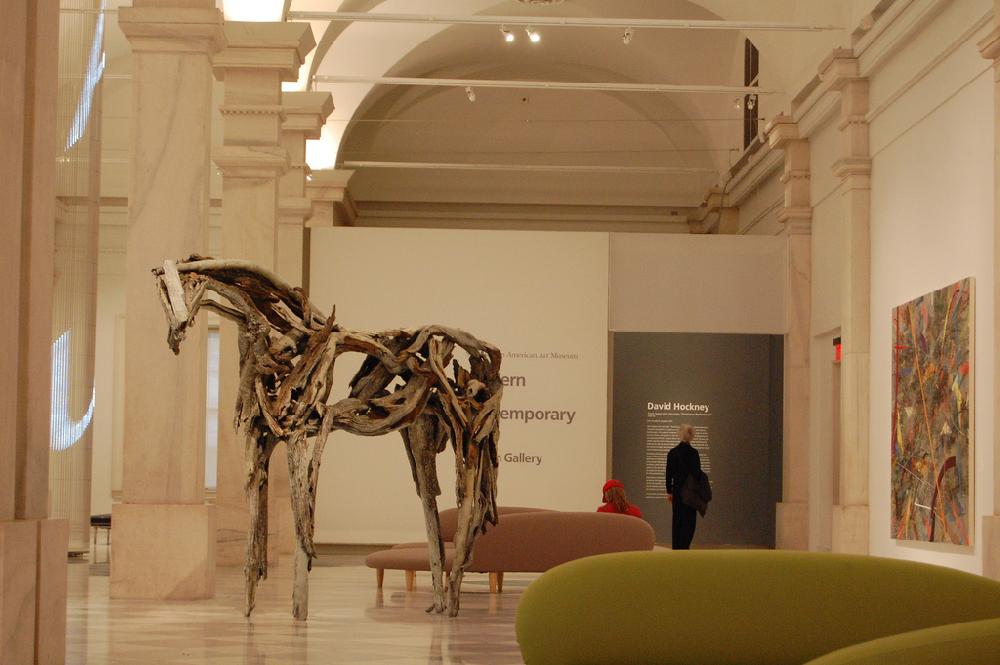 For a very long time museums have focused on buildings and galleries, revered physical spaces built to keep and display collections of stuff. Around all of this stuff museums have created content, the explanations and interpretations that help us make sense of our cultural past, present and future.
For a very long time museums have focused on buildings and galleries, revered physical spaces built to keep and display collections of stuff. Around all of this stuff museums have created content, the explanations and interpretations that help us make sense of our cultural past, present and future.
LAURA MUSACCHIO: MAKING SPACE FOR COMMONS by Shanai Matteson Urban landscape ecologist and ecological designer Laura Musacchio is concerned about how well people are adapting to the stresses of urban living in high-density cities and metropolitan regions, and how the proliferation of technology in their lives is transforming their urban experiences of nature including what urbanites like, know, feel, and appreciate about the natural world, other people, and non-human wildlife. This situation has raised a few questions for her about the physical commons as interactive spaces. "Social interactions are really the foundation for creating a civil society. We certainly see social interactions happening all the time online, but these are mediated through computers or mobile devices. What happens when this becomes the norm? When we have fewer and fewer reasons or opportunities to practice face-to-face interaction?" Laura pointed to some articles she had read recently about the impacts of social technology on the social skills of teenagers. When so much of the interactions that help people to build trust and understand human nature are done in the abbreviated world of text, what happens to our collective creative culture? Naturally Laura thinks about the spaces where this interaction can continue to happen. "In addition to some of the more obvious examples, like parks and plazas, cities have all sorts of leftover and unused space. How can we use it? How can we activate those spaces so that they become spaces for civic engagement? For a kind of cultural commons?" Laura sees the Walker's Open Field project as an experiment with exactly this question, and is excited to see what will happen when the public is invited to use the large open field for recreation, social interaction, education, or simply to gather. "It's like a giant lawn, and lawns can really act as a canvas for people." While chatting with Laura about her background, which combines design with ecology, I learned that she doesn't only think of people when she is considering the elements needed for a healthy cultural commons. "Practice with face-to-face social interaction, which is really what play is, that's important. So is connection to nature, to natural cycles that are present in cities, but often invisible to most people who live in these places. Understanding how they work is as important as understanding people and how they work." Many of us have probably heard of this idea of the Tragedy of the Commons, whereby individuals chip away at our shared limited resources. Laura is interested in the places where the physical and natural resources of space overlap with our cultural and civic lives. "Healthy civic spaces give us a sense of trust, and they inspire rather than hinder creativity. We know what the norms are, but we also believe that we can push the limits in new ways." This is what I find most exciting about the summer's Open Field project. In many ways it's a chance for us all to consider these questions, and also to test out some of ways that they might be addressed through creative public engagement. "I spend a lot of time on my computer, and when I do, I start to feel a distance from the physical spaces I share with others. I don't want to sound like I'm blaming technology, but I do worry that a lot of us are spending so much time immersed in digital social spaces that we are starting to put individual choice above the give and take of collective culture. I am not sure that's a good thing." Laura will share some examples from her own research and work at next Thursday's Open Field kick-off event. Photo credit: Laura Musacchio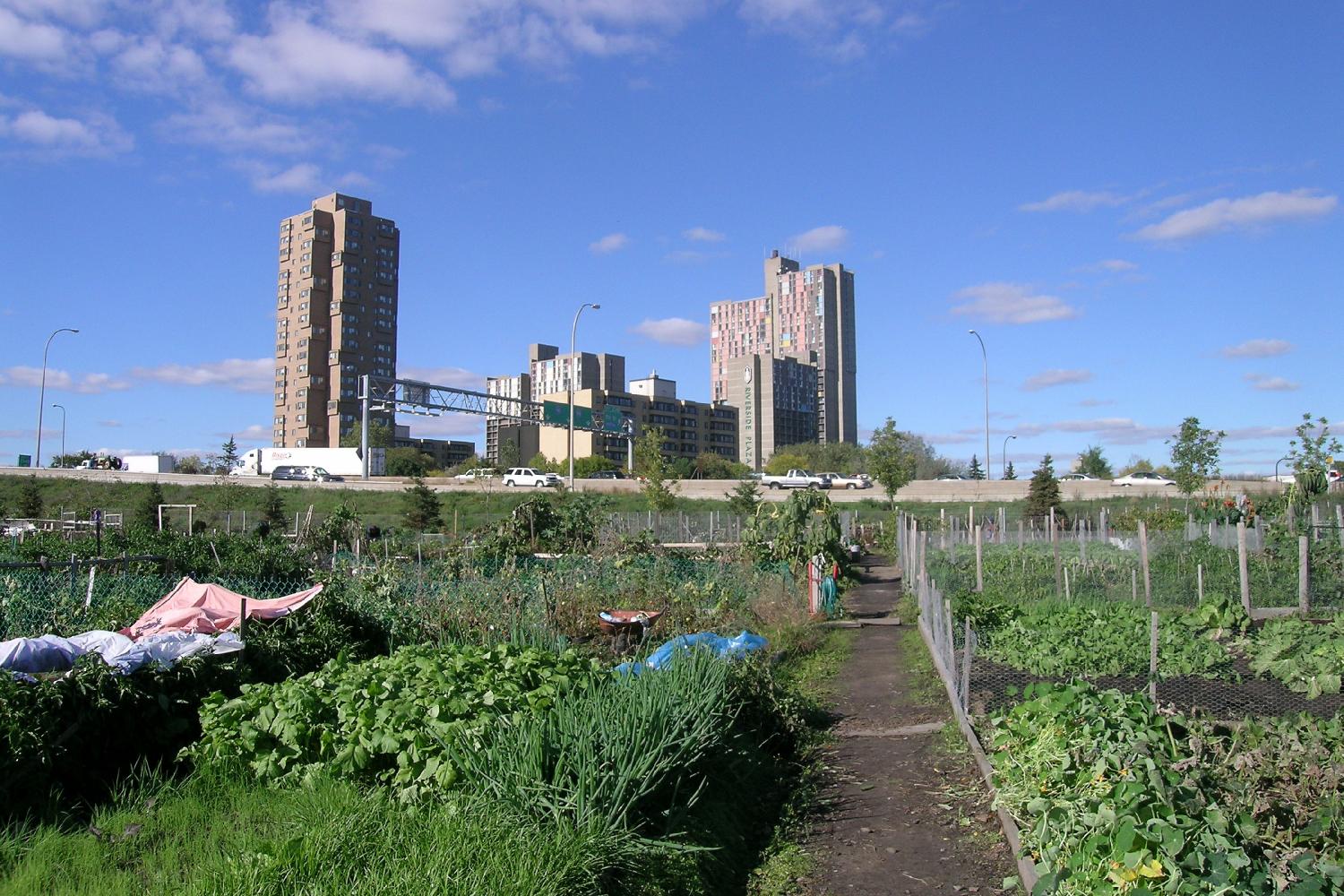 Much of the conversation that abounds about the cultural commons seems to focus on digital culture, which makes sense given the profound changes that have happened in technology over a relatively short time span. There's simply a lot that we still need to sort out.
Much of the conversation that abounds about the cultural commons seems to focus on digital culture, which makes sense given the profound changes that have happened in technology over a relatively short time span. There's simply a lot that we still need to sort out.
SUMANTH GOPINATH: MOBILE MUSIC, RINGTONES AND CULTURAL COMMONS by Shanai Matteson "The University has one of the best experimental composers in the world, James Dillon, working right here in town. He's absolutely amazing! And the School of Music brings some of the world's most creative performers to the Twin Cities. They host wonderful concerts that are open to the public and totally free." Although Sumanth is on temporary leave from the University while finishing a book project, he regularly attends the School of Music's concert series, just one of many untapped cultural resources he hopes more people will utilize. While talking with Sumanth about Open Field and the cultural commons, we learned that his interests and knowledge are wide-ranging. He sees myriad connections between digital technology, politics, culture and the everyday. He's critical of notions of cultural commons that don't take these connections into account. "Ours is a capitalist world-economy. One could argue that various forms of unpaid labor have always made capital accumulation possible, making practices like creative commons nothing more or less than part of a longer history of common repositories for cultural forms." Over the course of an hour our conversation meandered between the concept of commons in the writings of Karl Marx, Sumanth's own philosophical views on the production and dissemination of creative work, his passion for experimental music and art, and his interest in the global ringtone industry. "The ringtone is a remarkable cultural phenomenon that is demonstrating a high degree of popularity and is undergoing rapid transformation. It's a powerful lens through which to view the dynamics of cultural production." When it comes to questions of music production and the cultural commons, we often hear the familiar outcry that file-sharing and a laissez-faire attitude toward intellectual property, especially among those under 30, is killing the music industry. In fact, it's an argument that's been taken up again recently in the Atlantic (nice response here). Sumanth pointed out that the proliferation of ringtone versions of popular songs happened in tandem with the proliferation of pirated music. "Ringtone providers' increasing use of copyrighted popular music meant that music publishers were licensing material for ringtones and receiving royalties — thus planting the seed for the music industry's plan to make up for financial losses due to file sharing." Sumanth will be discussing these often overlooked connections at the Open Field kick-off, asking us all to consider the technological as well as the political histories of the creative tools we use, as well as the bits and bites of information that make them work and that provide access to art and culture. In many cases our mobile devices, small as they are, contain extensive libraries of music. Some of them even allow us to compose new works. In the case of ringtones, this music doesn't just play through our home stereos or headphones, it blasts unexpectedly in all kinds of private and public spaces, becoming part of the fabric of our physical commons, as well as our amorphous digital one. These questions of intellectual property, common ownership and the politics of cultural production will undoubtedly be raised again and again over the summer. For now, one thing Sumanth is interested in learning which ringtones visitors to the Open Field have chosen for themselves, and why. Anyone? I'll start by confessing that much to the annoyance of everyone around me my ringtone is set to an obnoxious Girl Talk mashup, which I am pretty sure I got from a free file sharing website. Because I am a freeloader. Photo credit: Ayton / CC NC-ND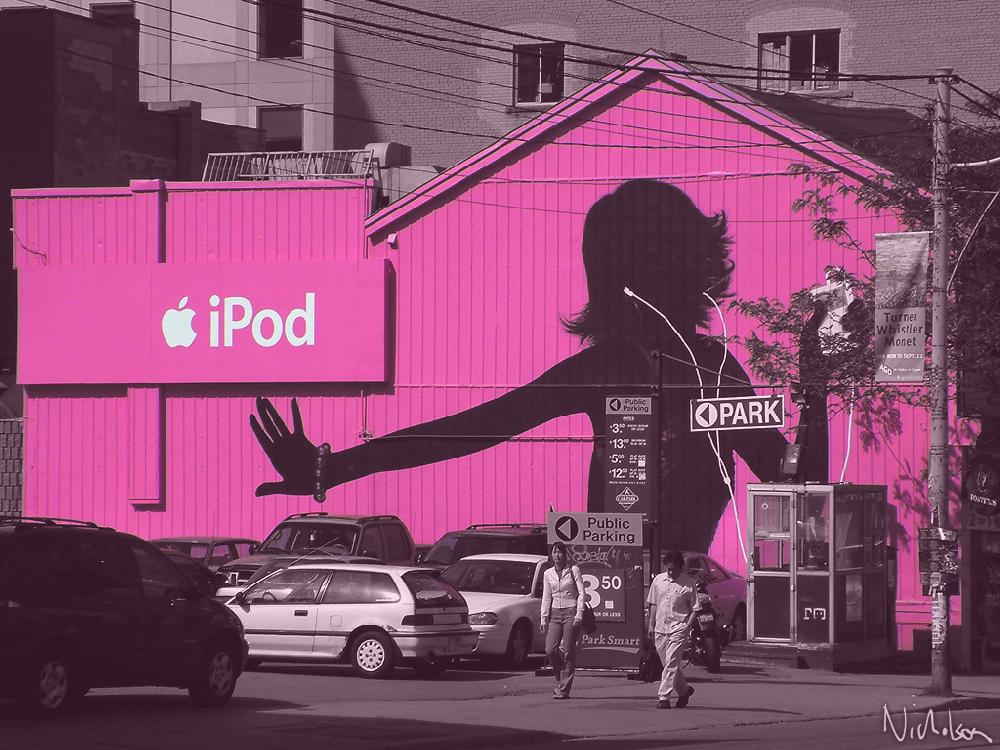 We met Sumanth Gopinath just a few minutes after he'd left an experimental music concert at the University of Minnesota, where he teaches music theory with a focus on globalization. From his emphatic description of the performance it seemed a wildly creative and moving experience, one that flew completely under the radar of most Twin Cities music fans.
We met Sumanth Gopinath just a few minutes after he'd left an experimental music concert at the University of Minnesota, where he teaches music theory with a focus on globalization. From his emphatic description of the performance it seemed a wildly creative and moving experience, one that flew completely under the radar of most Twin Cities music fans.
CAROLINE WOOLARD: EXCHANGE IN THE CULTURAL COMMONS by Colin Kloecker
"The law locks up the man or woman,
Who steals the goose from off the common.
But leaves the greater villain loose,
Who steals the common from off the goose."- An English protest chant, circa 1600, to object against the British Monarchy's habit of building fences around and on common land.
The idea of the commons has long been tied to ideas of exchange and livelihood. Who has control over resources? How are these resources shared, maintained, and valued? In the 1600's, talk about the commons generally referenced physical resources: open land for grazing livestock or the forest where firewood could be collected. Today, our definition of the commons has opened up considerably, but the ties to exchange and livelihood are still at the forefront of the discussion.
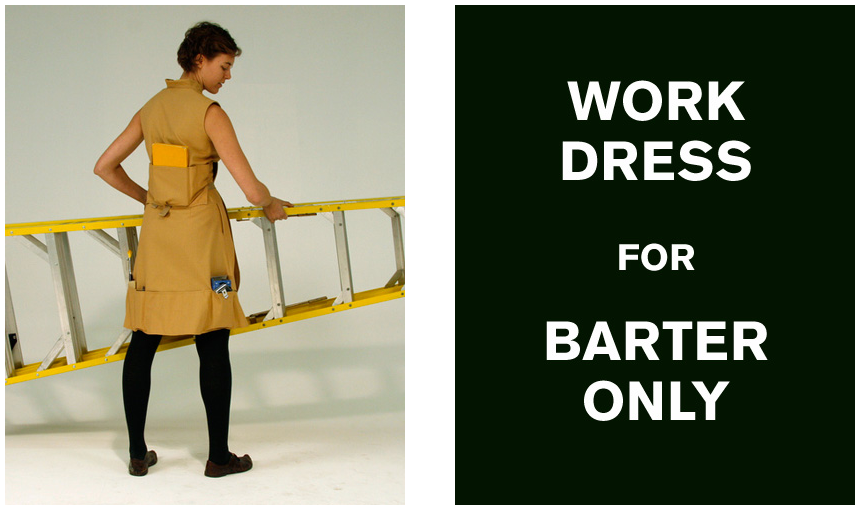 We asked Caroline Woolard to speak at Opening the Field because her work is a significant part of a movement advancing that discussion for makers, doers, and thinkers who have traditionally found it hard to monetize their skills and resources in our existing economy. Caroline is one of the founders of OurGoods.org, an online community of artists that facilitates barters of skills, space, labor, and art objects. The site matches barter partners, provides accountability tools, and tracks projects.
We asked Caroline Woolard to speak at Opening the Field because her work is a significant part of a movement advancing that discussion for makers, doers, and thinkers who have traditionally found it hard to monetize their skills and resources in our existing economy. Caroline is one of the founders of OurGoods.org, an online community of artists that facilitates barters of skills, space, labor, and art objects. The site matches barter partners, provides accountability tools, and tracks projects.
One morning a couple of weeks ago, Shanai and I spent about an hour Skyping with Caroline, who lives and works in Brooklyn, NYC. Before talking specifically about OurGoods, we talked about how she got to where she is today, about the nature of collaborative work, and about the difficulties and rewards of trying to keep an artist-run art space afloat (work we can certainly relate to).
Caroline really began thinking about exchange when she wanted to barter a dress she'd made for help designing and coding a website. The Work Dress is now an OurGoods pilot project, and a great example of the network in action. The garment is a hybrid tool belt/wrap dress, and is only available by bartering skills or resources with Caroline. To date, she has exchanged one for unlimited access to laundry facilities, a chapbook of poetry, lifestyle consultation, and expert help designing Work Dress 2.0.
Ultimately, OurGoods is an open-ended platform for the organization, support, and completion of creative projects. Beyond just facilitating person-to-person exchange, the site "offers a dynamic online environment in which artists can follow each other's creative development; organize "under the radar" artistic activity of their community; develop mutually supportive relationships offline; and learn new skills to enable their own work and the work of others." All without the need for cash funding from outside of the community.
The website is currently in an invite-only testing phase that is focused on the NYC area. Caroline talked about how this initial prototyping phase has been formative for troubleshooting everything from the user-interface to the way that actual exchanges are facilitated through the network. When bartering skills and resources, it's likely that at some point you're going to actually have to meet somebody in real world.
"Barter can be a really awkward thing. How do you find someone who has what you need and also wants what you have to offer? OurGoods.org is a diverse network of people, so it can play barter match-maker. But will everyone trust the site without meeting in person? To build trust and mutual respect for each-other, the best things is to combine the barter tool we've created online with face-to-face time."
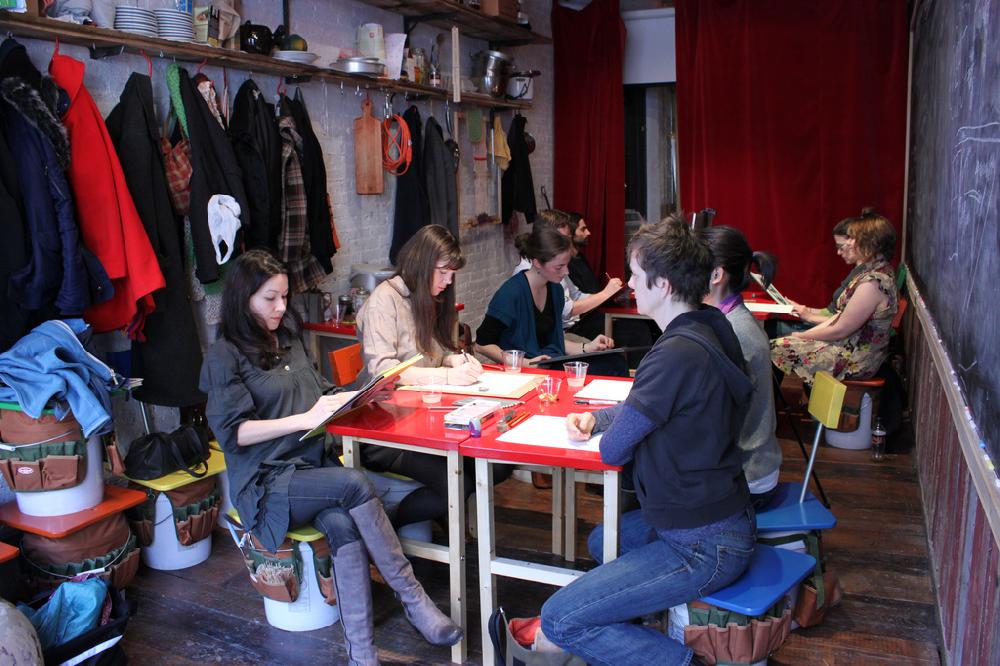 It was this face-to-face necessity that led to the creation of Trade School. From January 25th to February 28th, 2010, they hosted 35 days of co-working and classes for barter at a small storefront in the Lower East Side of Manhattan. Trade School offered over 70 different classes with topics ranging from grant writing and feltmaking to a three-day workshop called "Baudrillard Camp" that offered students that opportunity to "review, clarify, and immerse ourselves in Baudrillard's dystopian prognosis of the deterrence of the real by the virtual, information's profound function of deception, and spectacle as the terminal condition of late capitalist society." (Whew!)
It was this face-to-face necessity that led to the creation of Trade School. From January 25th to February 28th, 2010, they hosted 35 days of co-working and classes for barter at a small storefront in the Lower East Side of Manhattan. Trade School offered over 70 different classes with topics ranging from grant writing and feltmaking to a three-day workshop called "Baudrillard Camp" that offered students that opportunity to "review, clarify, and immerse ourselves in Baudrillard's dystopian prognosis of the deterrence of the real by the virtual, information's profound function of deception, and spectacle as the terminal condition of late capitalist society." (Whew!)
Rather then collect a pay check, or even offer their knowledge for free, teachers asked students for skills and resources in return for class time. Volunteer hours, fresh produce, vegetarian recipes, and personal stories on the class topic to share with the group were some of the things commonly exchanged.
OurGoods itself is a collaboration. Caroline is working with Carl Tashian, a developer and engineer who was the senior site engineer at Zip Car; designers Louise Ma and Rich Watts to create the site's user interface; and dancer/choreographer Jen Abrams is a long time member of WOW Cafe Theater (run by barter for nearly 3 decades) who is offering guidance and support.
Both OurGoods and Trade School are creating functioning models of exchange in the cultural commons. What lessons can be learned from these projects as we embark on the creation of a commons in our own backyard? How will conflicts be handled in the Open Field? What kinds of networks will we create to accomplish our new projects there?
These are all questions that Caroline will bring her insight to on Thursday evening at Opening the Field. But don't expect her to have all the answers! Ultimately, we can't help but think it's all going to come back to putting in some good old fashioned time with each other, face-to-face. (Which you can do, over beers, before and after the program!)Photo credits: Ourgoods.org
JON IPPOLITO: TOOLS FOR A HEALTHY COMMONS By Colin Kloecker A disastrous attempt to connect via video chat led us to a good old fashioned phone call with Jon Ippolito, who lives and works in Maine. Jon is an artist, writer and curator who speaks broadly about the commons, but also has deep experience in creating digital tools that facilitate collaboration across the web, and a networked approach to collective creativity and knowledge-sharing. Working out of Still Water, a New Media lab at the University of Maine at Orono that he founded in 2002 with Joline Blais, Jon has had his hands in numerous projects that often work to promote network art and culture. Two of the projects he is conceptual architect behind are The Pool and ThoughtMesh. Projects are visualized on a chart with an X and Y axis. The vertical position of a project signifies its current approval within The Pool community. Once added, projects literally sink or swim depending on how they are rated. The horizontal position of a project tells you how many times it's been reviewed. A project in the upper right of The Pool has been rated highly by a comparatively large amount of people. As you scroll over titles in The Pool, a short blurb about each will pop up, telling you the intent. Clicking a project brings up a dashboard where you can interact with the project's authors and others in the community in a number of ways. Jon has found that The Pool is most successful when there is a built-in community making use of it. At the moment, students from both the University of California at Santa Cruz and the University of Southern California are using The Pool to track class projects. Students from different schools have the opportunity to collaborate, review each others projects, and participate in the community as a whole. "It's interesting when you see these two different communities co-existing in the same virtual space. It became clear that students from the two coasts had some concerns in common, like Maine's and California's mixed records on same-sex marriage. At the same time, they had very different cultures; for example, the Californians misread satirical projects from Maine as serious proposals. Letting both student bodies interact in The Pool brought those differences and similarities into relief." We thought it appropriate to take some of Jon's work for a spin and create a ThoughtMesh document for this event. I've aggregated the five blog posts that introduce the five presenters for Thursday's event here: Opening the Field: A ThoughtMesh Introduction Once you click the link you'll see document navigation on the left, the ThoughtMesh tag cloud on top of the main column, and below that an abstract of the event. You can click through the navigation and read any of the introduction posts in their entirety, or you can use the tag cloud to search all 5 posts by keyword. Click on one of the keywords in the tag cloud to see which blog posts have been tagged similarly. If you click on "excerpts out," you're still searching with the same keywords, but now you're searching through every single document in the ThoughtMesh database. This is a great way to connect to other articles and essays you might be interested in. Jon thought this might prove a fun way to get acquainted with ThoughtMesh, so check it out and leave us a comment with your thoughts "" he might even call out for feedback at the event! A healthy commons needs tools that facilitate, connect, and nurture its inhabitants. Jon will be presenting these ideas, and more, on Thursday evening. ASIDE: LEARNING TO SHOW OUR UNDERWEAR When we talked with Jon, we also did a fair bit of shop-talk, which we really appreciated but I'll try not to bore you too much with here. Our conversation basically boiled down to Marshall McLuhan's mantra: The medium is the message. To what extent should an event like Opening the Field embody the values and beliefs that inspired the project in the first place? If Open Field is about opening up an institution, sharing knowledge, and creating a reinvigorated cultural commons in the Twin Cities, what kinds of tools do we use to talk about these ideas? "Don't show your underwear" is a saying that I've picked up from local projection art group Minneapolis Art on Wheels. While this is generally pretty solid advice all around, it has a special meaning in the world of projection art: don't let your audience see your desktop, dashboard, or software interface. When Works Progress co-produces large scale events like Opening the Field or 2008's Solutions for the Other 90%, we try very hard not to let our underwear show. We go to great lengths to aggregate the media content of all of our presenters into one seamless master presentation. We set it all up and we hit "full screen" and we cross your fingers that it stays in full screen mode all night long. In talking with Jon, it became increasingly clear that this strategy was neither appropriate or advantageous for this situation. Providing panelists with interactive tools like a Web browser might help them better respond to participation from the audience, as befits a program on sharing and the commons. Presenters at Opening the Field will be able to toggle back and forth between Keynote, Firefox, and any other application or web tool they might find useful in presenting their ideas. On Thursday night, we're going to show you our underwear and you have Jon Ippolito to thank for that!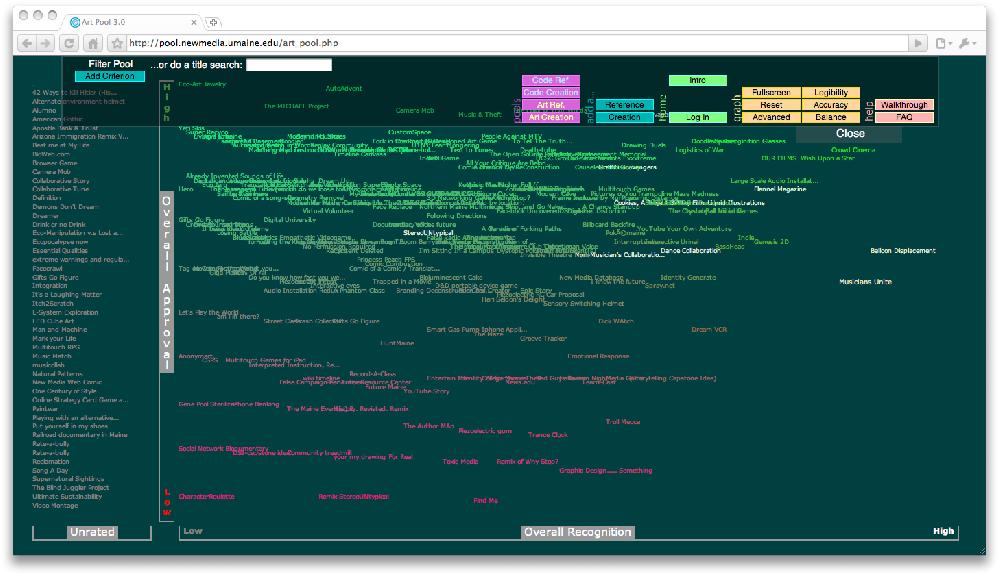 The Pool is a "collaborative online environment for creating art, code, and texts." Diving right into The Pool can be a bit confusing at first, but with the aid of this walkthrough, you'll quickly learn your way around.
The Pool is a "collaborative online environment for creating art, code, and texts." Diving right into The Pool can be a bit confusing at first, but with the aid of this walkthrough, you'll quickly learn your way around.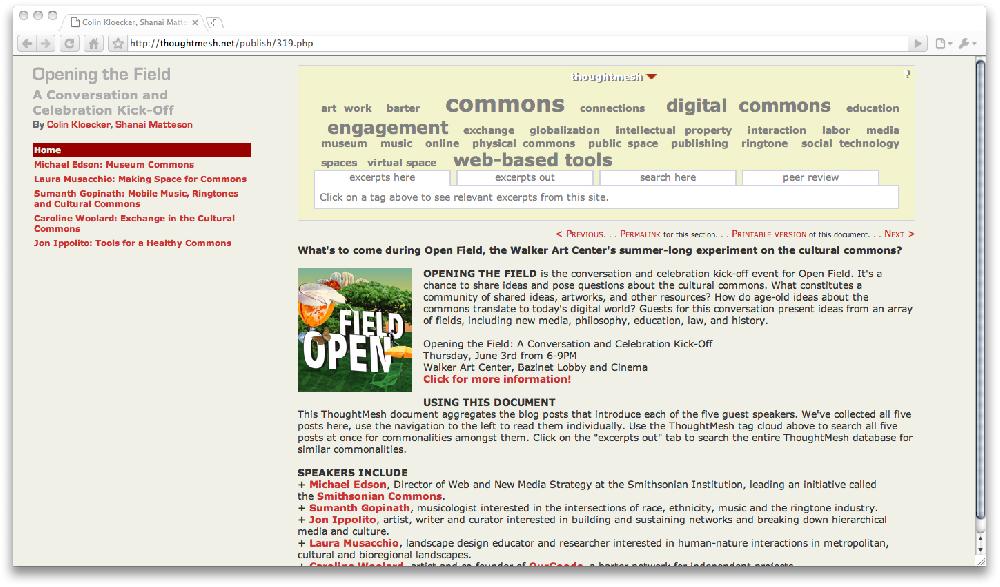 ThoughtMesh is a tool for publishing online that began to materialize when Jon and Craig Dietrich started thinking about what their ideal publishing software would look like, if they could build it from the ground up. What they came up with is a tool that allows published articles to live socially on the web, articles can be distributed and published on any website online. At the same time, every essay, article, and document are connected to each other. And of course, it's easy to use, easy to share, and works as a non-linear presentation tool to boot!
ThoughtMesh is a tool for publishing online that began to materialize when Jon and Craig Dietrich started thinking about what their ideal publishing software would look like, if they could build it from the ground up. What they came up with is a tool that allows published articles to live socially on the web, articles can be distributed and published on any website online. At the same time, every essay, article, and document are connected to each other. And of course, it's easy to use, easy to share, and works as a non-linear presentation tool to boot!